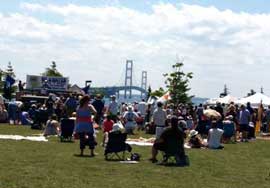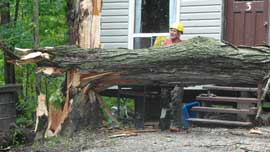Enbridge Energy plans to expand Great Lakes pipeline
ST. IGNACE—Jim Nies is dedicated to helping to preserve and restore the pristine heritage of the Great Lakes (and Manitoulin Island in particular) waters. As a member of the Manitoulin Area Stewardship Council (MASC) the Island resident (Mr. Nies divides his time evenly between summers in Kagawong and winters in Whitewater, Wisconsin) knew what he needed to do when learning of plans for a protest against a proposed expansion of an Enbridge Energy pipeline entitled ‘Water and Oil Don’t Mix.’
“I wanted to be there to lend moral support,” he said. “As a member of MASC I thought it was important that we have someone there to show our support.”
The rally was attended by around 400 supporters, according to media reports, and was organized by Traverse City 350, a chapter of the environmental group whose website is located at 350.org and took place within the shadow of the international Mackinac Bridge.
“I don’t know if rallies and signing petitions really accomplish a lot,” said Mr. Nies. “But you have to do something to help turn around the tide.”
Part of what galvanized Mr. Nies’ alarm was the realization that Enbridge Energy was the company which owned and operated a pipeline on the Kalamazoo River when nearly a million gallons of heavy oil was spilled from a leak. “This company has had more than 800 oil spills from its pipelines since 1999,” he said. “Their pipelines in the Straits of Mackinac are over 60-years-old and they want to increase the amount of toxic and corrosive tar sands oil from Alberta through them.” If the pipelines are failing under the current loads, suggests Mr. Nies, “what is going to happen when they start shipping even more corrosive material through them?”
Mr. Nies noted that organizers with 350.org spoke to the crowd, they learned that when the Kalamazoo spill first occurred, it took several hours for the company to respond. “When the alarms went off in Edmonton,” he said, “they didn’t shut the pipeline down for 18 hours.” The result, said Mr. Nies, was that local residents had to be evacuated from the area and the oil spill killed local wildlife. “Now they want to send through another 50,000 barrels a day,” he said. “The added pressure through those 60-year-old pipes could produce an environmental disaster on an epic scale.”
Currently more than 20 million gallons of crude oil and natural gas fluids are pumped through Enbridge Energy pipelines submerged in the Straits of Mackinac.
For environmentalists concerned about Great Lakes waters, Enbridge Energy has become public enemy number one, said Mr. Nies.
Among the speakers at the rally were 350.org founder Bill McKibben and National Wildlife Federation policy expert Beth Wallace. Ms. Wallace, who grew up on the banks of the Kalamazoo River, was witness to the 2010 spill. On July 2010, a 30-foot section of the Enbridge Energy pipeline collapsed into Talmadge Creek upstream from the Kalamazoo and then 35 miles down the river.
“The entire river was filled with oil,” she recalled. “A muskrat was desperately trying to clean itself and was failing miserably.”
In the end, the Kalamazoo spill was the largest inland spill in midwestern American history and more than 320 people reported crude oil exposure symptoms and affected more than 50 miles of waterways and wetlands.
“They had to invent whole new technologies for cleaning up the heavy oils that sank to the bottom of the river and the lakes,” he said. The cost of the eventual cleanup topped $800 million and according to the National Transportation and Safety Board, is the costliest inshore spill cleanup in US history and remains incomplete.
“The oil and gas industry had been able to get away with business as usual for a long time without too many people asking questions, including our (US) regulators,” said Mr. Wallace. “Now people are asking the important questions and demanding answers and, in many cases, demanding change.”
A key part of the issue for those championing the integrity of Great Lakes waters is the refusal of private companies to release reports on the condition of the pipelines.
“Those waters provide drinking water to 30 million people on both sides of the border,” said Mr. Nies. “There is a $7 billion tourism industry and $16 billion in recreational boating that also depend on the Great Lakes waters in that region.”
In addition to the crude oil itself, Mr. Nies notes that the oil from Alberta’s tar sands is diluted with benzine in order to make it easier to pump. “Benezine is a well-known carcinogenic material,” he said.
Mr. Nies said that he has no faith in the US or Canadian governments to deal with environmental issues or to safeguard the heritage of future generations from the predations of global corporations. “Politicians should listen to the people,” he said. “The US congress is completely useless. I think Stephen Harper is the worst thing that has happened to the environment in Canada. I hate to see corporations setting the agenda for the environment. They have proven time and again that they cannot be trusted.” Mr. Nies cited the literally hundreds of environmental violations Enbridge Energy has been charged with both prior and following the Kalamazoo spill.
“They knew about the defect in the Kalamazoo pipeline five years before the spill and no one forced the company to do anything about it,” he said. “Now we are supposed to trust them to increase their pipeline capacity by millions of gallons of heavy crude? That is just crazy.”





